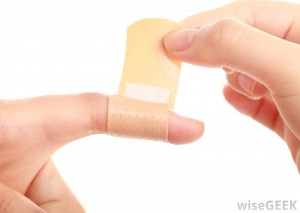Have you ever taken any time out of your day to research why paper cuts hurt so much? No? Well I have and let me tell you, the science behind a paper cut is much more complex than you may think. When you get a paper cut, not only do you have to accept the fact that you were injured by a seemingly harmless sheet of paper, but you also have to endure the constant pain faced while doing anything involving your hands.
A combination of the properties of your hand and the properties of paper makes paper cuts the biggest pain of an injury. To start, according to an ABC news article titled “The Peculiar Pain of Paper Cuts”, your hands are full of nociceptors. Nociceptors are nerve endings that shoot signals of pain to the brain if one’s skin is experiencing enough pressure or temperatures extreme enough to damage tissue. Paper cuts are often deep enough to expose these nerve endings, but not deep enough to draw blood. This lack of blood keeps the paper cut from clotting and leaves the nociceptors exposed for longer periods of time. This constant exposure to the air causes dull pain that does not seem to go away until the cut is healed. Humans use their hands for almost everything they do and this constant movement of the skin on the hands causes paper cuts to reopen.
s stated previously, the hand is not the only thing to blame for the pain of a paper cut. Although it may seem smooth, on a microscopic level, the edge of paper is very jagged. This dull serrated pattern causes paper to cut like a saw and leaves a rough cut behind. The process of creating paper also involves many chemicals. When an individual gets a paper cut, some of the chemicals used in bleaching the paper are left behind in the wound causing irritation.
The edge of paper at 100x magnification
Now that I have informed you why paper cuts are so painful, I think it would be appropriate to tell you the best way to treat a paper cut if you are unlucky enough to receive one. The first thing you should do when you get a paper cut is flush the wound out with cold water. After you have flushed the cut out with water, gently wash the cut with soap making sure not to reopen the wound. After the cut is cleaned with soap, apply antibiotic cream and apply a bandage.
Sources:
http://www.wikihow.com/Treat-a-Paper-Cut
http://abcnews.go.com/Health/PainManagement/story?id=4258917&page=1
http://www.ncbi.nlm.nih.gov/pmc/articles/PMC2964977/



This blog grabbed my attention as I was scrolling down the dashboard. How can something so minor hurt so much? It’s crazy how one little cut can sting and throb so much. It’s kinda like stubbing your toe. The instant you get it, you know you’re in for some pain. In this article, http://www.healthhype.com/fingertips-pain-tenderness-and-sensitivity-causes.html, it tells you about the sensitivity in the fingertips. Our fingertips are extremely sensitive because it contains a very high amount of nerve endings. Which is why I will never let my doctor prick my finger. I always make him take blood out from my arm because my finger would be sore for days. However, I will be sure to follow your directions on what to do after getting a paper cut!
I think this is the most interesting blog post I’ve read. I’ve never really stopped to think about it, but paper cuts do hurt a surprising amount. The picture is the most shocking part, as I can’t even imagine that paper could have jagged edges. How could something so thin and straight look like that on a microscopic level from the edge. I found a video (link is below) that summarizes most of what you said, but the person in the video also believes that people pay more attention to a paper cut because it is on the hands, which is one of the most used body parts.
I found this very interesting to read because it is very relatable. I cant even tell you how many times I have gotten a paper cut. They are sooo small but seem so be soo much more painful than other cuts. This blog post clears this up for me. The high pain makes a lot of sense because of the nerve ending on our fingers. There are tons more here than on other parts of our body. Also that close up picture of the edge of a piece of paper is scary. No wonder they are so dangerous. The jagged edges get hooked on to your skin and cut you like a saw. Ew. Overall, I think this was a very interesting blog post because I know that everyone here can relate. Maybe next time ill try your tips for the best way to treat a paper cut.
Hey Hannah, Glad you liked the blog. one thing I found very interesting about the amount of nerve endings on your hand compared to other places on your body was a test called “two point discrimination”. if you were to get something like a paperclip, fold it in a half and touch your hand, you would most likely feel two points of contact while if you were to touch a part of the body with less nerve endings, like your shoulder, it would be hard to distinguish between both point os contact.
You can read more about two point discrimination here